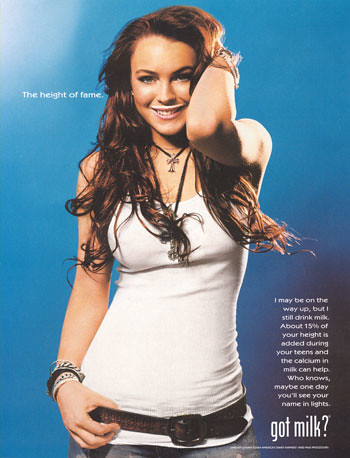
Without the helpful input of highly compensated celebrity endorses, how would we ever know what to like? Certainly we as consumers can't be trusted to make these sort of decisions for ourselves. Just imagine all the crazy things we would get into without the ever-sage guidance of paid spokespeople. No, we need to be told what to do from people we know from movies, sports, music, and television. They're pretty much our only reliable sources.
In 1994, the dairy industry had fallen upon hard times. Kids had tasted the forbidden sugariness of soda and it seemed that they had reached the beverage point-of-no-return. The once-ubiquitous cafeteria milk cartons had been replaced by Coca-Cola sponsored vending machines sure to fund our schools and cavitate our teeth. Our bones were brittle, our blood sugar was high, and we knew little of the beloved milk of our forebearers. Milk producers knew it was time to take action.
 Milk producers knew they needed something a bit punchier than "Milk: it's Cool" Cafeteria Milk Machines
Milk producers knew they needed something a bit punchier than "Milk: it's Cool" Cafeteria Milk MachinesThe bottom line was that kids were not convinced that milk was cool. I know what you're thinking, kids weren't won over by the glamorous lives of those in the dairy industry? Next thing you're going to tell me is that they were careless about maintaining their calcium levels. Hard to believe, yes, but milk's image was on a downswing. It was as if milk was some washed-up celebrity past her prime; once cast in great roles, she was now generally relegated to grandmother and old-version-of-young-starlet type parts. Milk producers knew they had to act fast if they were going to bring their former key player into the spotlight again after 30 years of poor management and competition from sexier thirst-quenchers.
Milk was down, but it was not out. Advertisers knew that if they could just convince the youth market that milk was hip and happening, kids would drink it up. Ripped straight from the dark imaginations of focus groups, the initial campaign focused on the horrifying consequences of finding oneself in a situation that demanded milk but where none was available. Frightening, I know. Just imagine, a mouthful of cookie with nothing to chase it down. A dire crisis, indeed. Marketers even referred to this as the "Milk Deprivation Strategy," to give you an idea of the seriousness with which they approached their dalliance with dairy.

Milk knew it needed to get by on more than association alone. Sure, cookies had reasonable child street cred, but they could only take milk so far. Advertisers knew they needed to up the ante a bit and inject some humor to hold people's interest and draw attention to their campaign. Continuing on their general milk deprivation theme, they released this television spot:
We can all relate to this situation. How many times do you find yourself, a devoted Aaron Burr historian and enthusiast, faced with the most simple question in your major area of study yet unable to answer due to unfortunate peanut butter stickiness side effects? Too many to count.
Soon, the phrase "Got Milk?" was everywhere, and as you can imagine, it did not dwindle in its humor or become even minutely annoying the 467th time you saw a t-shirt emblazoned with a "Got _________?" slogan. Endlessly hilarious.



The true heart of the campaign was in the print ads we all so know and love. Originally christened with such creative and demanding slogans such as "Where's your mustache?", these teen-attracting ads were soon absorbed under the larger Got Milk? ad campaign umbrella. Celebrity models sported somewhat unfortunate-looking milk mustaches as marketing teams superimposed witty first-person copy clearly not to be attributed to the person pictured in the ad. Regardless of the falsified text, preteens adored these ads. Young girls plastered the walls of their rooms with them, as if these omnipresent magazine advertisements were rare and collectible. There was even a book published full of these ads featuring behind-the-scenes information about the mustachioed celebs. I am only slightly embarrassed to admit that I owned this book and possibly read it cover to cover, seeking the goodness of milk in light literary form.
These ads were well-targeted and smart. Marketers knew that 90s children pledged essentially undying and unwavering devotion to their celebrity role models. Despite the fact that these celebrity teen role models were generally unqualified to preach anything and would go on to make all sorts of unfortunate life choices, in the 90s their innocence was still intact:



Aren't you glad we listened to these wise, learned teen stars and drank all the milk we could get our hands on? At the time, we wanted to grow up to be just like them. Unfortunately, at the time these ads ran, these adolescent celebrities had yet to grow up themselves. The versions of them that we looked up to had yet to reach their milk-inducing potential. Nowadays, these all-grown-up former teen sensations may not be the picture of wholesomeness and stable health, but at the time we saw them as pure milk success stories.
Sure, the ads also featured real role models like triumphant Olympic athletes, but if you weren't into sports it seemed the best you could wish from milk was to end up like Britney Spears or Lindsay Lohan. Now aren't you glad you listened to these good mustachioed people and drank your milk?
Check it out:
Official Got Milk? Website
MooMilk: A Dynamic Adventure into the Dairy Industry
Got Milk? Ads Photostream






0 comments:
Post a Comment